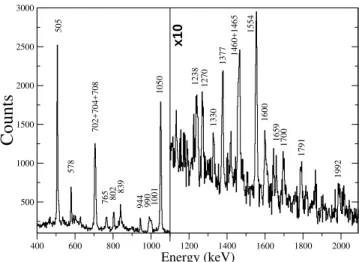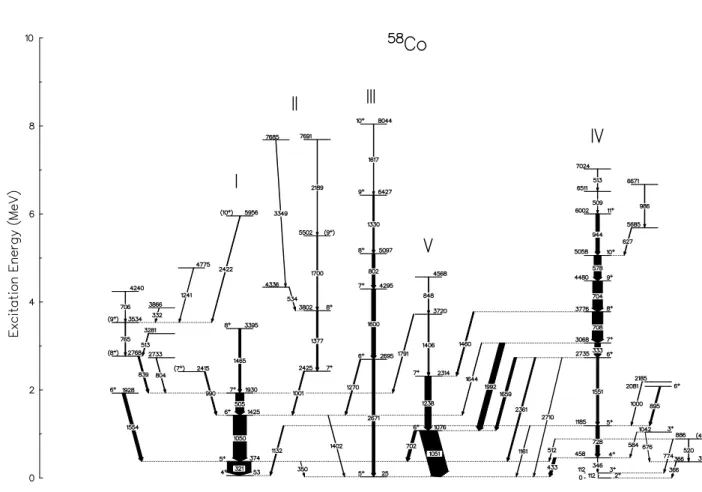Brazilian Journal of Physics, vol. 35, no. 3B, September, 2005 821
In-Beam Gamma Ray Spectroscopy of
58
Co
M. A. G. Silveira, N. H. Medina, J. R. B. Oliveira, J. A. Alcˆantara-Nu˜nez, E. W. Cybulska, H. Dias, M. N. Rao, R. V. Ribas, W. A. Seale, and K. T. Wiedemann
Instituto de F´ısica, Universidade de S˜ao Paulo, S˜ao Paulo, SP, Brazil
Received on 12 November, 2005
The odd-odd58Co nucleus has been studied with the51V(10B, p2n) reaction at 33-MeV incident energy and theγ-spectrometer Saci-Pererˆe. Excited states up to 8.0 MeV and spin up to 11+ have been observed. The results are compared to Shell Model calculations using the GXPF1 effective interaction, developed for use in the fp shell. Theπf−7/12⊗ν(p23/2f15/2) configuration was assigned to the yrast levels.
Nuclei close to doubly magic shell closures are the object of extensive experimental and theoretical investigations [1– 3]. Spectroscopic data from these nuclei provide essential in-formation for the parameter sets of spherical shell-model cal-culations. They apply severe constraints on the outcome of such calculations and, consequently, define the effective nu-clear forces. During recent years both experimental and theo-retical efforts have been used to understand the nuclei near the Z=N=28 shell closure. There is an N or Z=28 “magic” num-ber inside the major shell with the oscillator quantum numnum-ber N=3. The shell gap at N=Z=28 is due to the spin-orbit lowe-ring of the f7/2orbital. This gap is relatively small so that the particle-hole excitation across the gap has relatively low ener-gies. For shell model calculations around this magic number, 56Ni has often been assumed as an inert core. However, it has been shown that this core is rather soft and only a very limited description is provided by the closed-shell model for the ma-gic number 28 [4]. These structures were successfully descri-bed for N or Z = 28 nuclei only after considering the existence of significant core-excitations in low-lying non yrast states as well as in high-spin yrast states [3]. These calculations were performed for the53Mn,54Fe,55Co and56,57,58,59Ni nuclei.
In this study we present new results on excited states of 58Co, thus enriching the systematics of the nuclear structure along the N=31 chain. This nucleus has three particles and one hole relative to the56Ni core and has been studied so far with proton andαparticle induced reactions [6–8], therefore very little was known regarding its high-spin structure.
The58Co nuclei were produced with the fusion-evaporation reaction 51V(10B,p2n) at 33 MeV bombarding energy, with the 8MV Pelletron accelerator of the University of S˜ao Paulo (USP). The target consisted of a stack of 3 self-supporting natural 51V foils of 200 µg/cm2. Gamma-gamma-charged particle coincidences were measured with the Saci-Pererˆeγ -ray spectrometer. Saci [9] (Sistema Ancilar de Cintilado-res) is a 4π- charged particle system consisting of 11 plastic phoswich scintillator△E-E telescopes. Pererˆe [10](Pequeno Espectrˆometro de Radiac¸˜ao Eletromagn´etica com Rejeic¸˜ao de Espalhamento) is aγ-array spectrometer composed of 4 GeHP detectors with BGO Compton shields (two detectors were Or-tec GMX of about 20% efficiency and the other two were
400 600 800 1000 1200 1400 1600 1800 2000 Energy (keV) 500 1000 1500 2000 2500 3000
Counts
505 1050 1238 1270 702+704+708 1377 1460+1465 1554 578 990 944 802 1992 839 1791 1600 1659 1700 1001 1330 765 x10FIG. 1: Gamma-ray spectrum from the10B on51V (E=33MeV) ga-ted on the 321keV low-lying transition of the58Co nucleus, and on protons detected by the SACI array. These gamma-rays were assig-ned to the58Co nucleus.
Canberra REGe of 60% efficiency). Two of these detectors were placed at 37o and the other two at 101o with respect to the beam direction. Events were collected when at least two HPGe detectors fired in coincidence. The charged parti-cle detectors were screened against the scattered heavy ions with three Al foils of 3.0mg/cm2. A total of 48×106 Comp-ton suppressedγ−γ events was collected and registered on the hard disk of a PC.γ−ray energy and efficiency calibra-tions were made with56Co,133Ba, and 152Eu sources. The data have been Doppler corrected and sorted into symmetrized
(corres-822 M. A. G. Silveira et al.
FIG. 2: The partial level scheme of58Co obtained from the present work.
ponding to the p3n channel), which is the main contaminant channel in the 1p-gated spectra, were identified from previous work [14]. The assignment of the spins to the58Co levels was based on the DCO (directional correlation from oriented sta-tes) ratios. Aγ-γmatrix was constructed by sorting the data from the 2 detectors positioned at 37oand 101o. Gates were set on both axes on several strong dipole transitions and the intensity of other transitions observed in the two spectra has been extracted. We have assumed only positive parity states since the shell model does not predict negative parity states in 58Co within the excitation energy and spin limits of this work. A level scheme extending up to an excitation energy of about 8.0 MeV and spin Iπ=11+
has been proposed, based on the coincidence relationships, intensity balances on each level and energy sums from different paths using the 1p-gated matrix (see Fig. 2). Several cascades at high excitation energy suggest a complex level structure. We have found 46 newγ-transitions de-populating 37 new excited states. The level energies are referred to the low-lying 2+
state previ-ously known [15]. The placement of the transitions in the
le-vel scheme is firmly established by coincidence relationships. The width of the arrows is proportional to the intensities of transitions as seen in the reaction studied here. The relative in-tensities of weaker transitions, with respect to the strong ones, have been deduced from coincidence spectra.
In order to understand the observed structure, spherical shell model calculations have been performed with the code MSHELL [16]. We have used the model space and the re-sidual interaction named GXPF1, developed recently for the description of fp-nuclei [3, 5]. The calculation with the GXPF1 interaction was performed in the full fp shell with up to 8 particle excitations from the 1f7/2 orbital to the 1p3/2, 1f5/2and 1p1/2orbitals.
To make a correspondence between a predicted level and a detected level means that both the level energies and the de-cay patterns should be in fair agreement. For the seven lowest yrast levels, including the g.s., the largest disagreement is for the 3+
impor-Brazilian Journal of Physics, vol. 35, no. 3B, September, 2005 823
FIG. 3: Comparison between experimental and theoretical yrast ex-cited states in58Co.
tant. In Fig. 3 a comparison of the experimental level energies with the calculations for the yrast excited states of the odd-odd nucleus58Co are shown. These calculations compare
reasona-bly well up to the excited yrast 8+
state. The yrast states were interpreted asπf−7/12⊗ν(p23/2f15/2).
In conclusion, the level scheme of the odd-odd58Co nucleus populated with a heavy ion fusion-evaporation reaction was measured for the first time. The shell model calculations re-produce well the experimental yrast states. Additional level assignments are being performed and should allow a more de-tailed comparison with the theoretical results. More experi-mental information on nuclei in the region of56Ni and, in par-ticular, lifetime analysis for the excited states in58Co, which are in progress, should improve the knowledge of the high spin state features.
The authors would like to thank Prof. B. A. Brown for fruitfull discussions and Prof. T. Mizusaki for providing the MSHELL calculation results. This work was partially sup-ported by the Fundac¸˜ao de Amparo `a Pesquisa do Estado de S˜ao Paulo (FAPESP) and the Conselho Nacional de Desen-volvimento Cient´ıfico e Tecnol´ogico (CNPq), Brazil.
[1] A. F. Lisetskiy et al., Phys. Rev.C68, 034316 (2003). [2] D. Rudolph et al., Eur. Phys. J. A4, 115 (1999). [3] M. Honma et al., Phys. Rev. C69, 034335 (2004).
[4] T. Otsuka, M. Honma, and T. Mizusaki, Phys. Rev. Lett.81, 1588 (1998).
[5] M. Honma et al., Phys. Rev. C65, 061301 (2002).
[6] B. Elandsson and A. Marcinkowski, Nucl. Phys. A 146, 43 (1970) .
[7] A. C. Xenoulis and D.G. Sarantites, Nucl. Phys. A 170, 369 (1971).
[8] B. J. Brunner et al., Phys. Rev. C11, 1042 (1975).
[9] J. A. Alcˆantara-Nu˜nez et al., Nucl. Inst. Meth. A 497, 429 (2003).
[10] R. V. Ribas et al., Ann. Rep. of the Nucl. Phys. Dep. IFUSP, 63 (1996).
[11] W. T. Milner, Holifield Heavy Ion Research Facility Computer Handbook, Oak Ridge National Laboratory, Oak Ridge, Ten-nessee, USA (1987).
[12] D. Bazzacco, Private comunication, INFN Sezione di Padova, Italy (1996).


